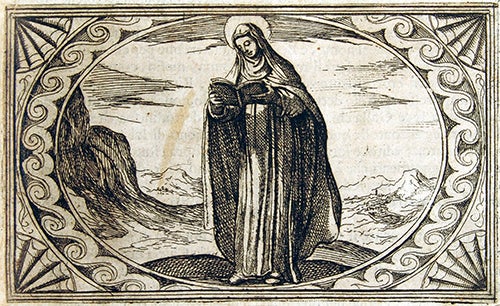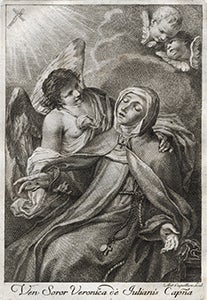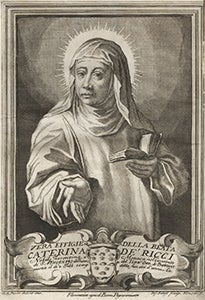
Introduction
click here to download the exhibition brochure (PDF, 681 kb)
The nearly 1,500 volumes that constitute the Thatcher Collection will be a treasure trove for researchers and a source of delight for the general public. These books weave a rich and varied tapestry. Above all they provide insight into the spiritual lives of early modern women, but also those of men. They offer vivid descriptions of the devotional practices of nuns, but also of laywomen. They tell us about the humdrum routines of everyday life, but also of defiance, sacrifice, martyrdom, and heroic deeds carried out in defense of the faith. They speak of love of God, but also of erotic yearning. They are in Italian, French, Spanish, Portuguese and English, and some are translations from German and Latin. The diversity of languages conveys both the amplitude and unity of Catholic culture. Taken as a whole, these books greatly enrich our knowledge of the early modern world, and in particular, of the lives of women.
Most of the books in this collection are “Lives,” spiritual histories called Vite in Italian, Vidas in Spanish, or Vies in French. A vita is not strictly speaking a biography, but a spiritual memoir. It can include biographical material, but also spiritual musings, prayers, anecdotes, and descriptions of visions or locutions. Most Vite were written by men, often by priests seeking to promote their spiritual daughters to enhance their own reputations. However, some women wrote their own “Lives.” Teresa de Ávila (usually called Teresa de Jesús outside the U.S.) was an avid writer, and many subsequent nuns followed her lead. Like Teresa, they wrote at the command of a male spiritual director. Nevertheless, they maintained agency by describing their own thoughts in their own words.
This exhibition includes some eighty representative books, but what was omitted is as noteworthy as what was included. We have featured two religious orders, the Society of Jesus and the Discalced Carmelites, because the burgeoning of these two orders in many ways defines the spiritual reform that swept through Catholic Europe in the sixteenth century. Both the Jesuits and the Discalced Carmelites promoted a new kind of spirituality, one that was not based on rote recitation of established prayers, but on a deep personal relationship with God. The Jesuits were instrumental in helping Saint Teresa launch the Carmelite reform and in promoting female spirituality in general. As the Thatcher Collection evinces, they wrote the vite of many spiritual women, most but not all of them nuns. After Saint Teresa founded the first Discalced Carmelite convent in 1582, the reform spread rapidly throughout Spain and then, after her death, the rest of Europe and the Americas. Aside from the Carmelitana Collection at the Carmelite monastery at White Friars Hall, Georgetown University contains the most significant compilation of early Discalced Carmelite documents in the area. The Thatcher Collection also contains important books on other orders as well, the Dominicans, the Benedictines, and Franciscans. Women’s Studies scholars will be particularly interested in the holdings on the Ursulines’ establishment of schools and hospitals in Canada.

The largest segment of the exhibition, “Portraits in Piety,” consists of forty-six books that provide a rich and varied view of female piety through both graphic representations and text. The images speak in large part for themselves. In addition to traditional portraits of nuns kneeling before religious artifacts, they include depictions of women reading or writing, acts of heroism by women, works of charity, and miracles such as Saint Maria Maddalena de’ Pazzi painting an image of Christ while blindfolded. All of these images are part of much more complex portraits composed of the texts themselves. Although the focus of both the Collection and the exhibition is women, several great men are depicted here as well. These include Saint Francisco de Borja, Saint Pedro de Alcántara, and Saint Carlo Borromeo. In addition, most of the histories of orders and compendia of model lives feature male figures.
Another segment of the exhibition, “Women and Books,” highlights women as authors, publishers, and sponsors. This segment was originally conceived as part of a larger presentation of both highly accomplished women such as political, intellectual, and religious leaders, and of more ordinary women, including wives, mothers, and widows. Space limitations caused us to eliminate books on fascinating subjects such as Luisa de Carvajal y Mendoza (1566–1614), a Spanish noblewoman who made the daring decision to travel to England to convert Anglicans back to Catholicism. Also not included owing to lack of space are numerous conduct manuals in different languages that define acceptable behavior for Catholic women. These books provide insight into societal norms concerning demeanor, sexual behavior, women’s education, daily activities, and family relationships.
The breadth of the Thatcher Collection enables us to appreciate the phenomenal evolution of book technology from the early sixteenth century to the twentieth. However, the Collection provides information not only about how books were made but also about why. Many of these books were designed to facilitate prayer or to provide spiritual role models. Some were created to advance the beatification of a beloved relative or spiritual daughter. Still others served to promote a particular order by lionizing a founding saint. Sometimes an order sought to enhance cohesiveness among its members by chronicling its history or creating prayer guides to reinforce its charism. Often a city or town published vite of local holy people to enhance its reputation.

The Thatcher Collection contains few books in English written prior to the nineteenth century. Catholic activities, including publishing, had been restricted in England, and not until passage of the Catholic Relief Act of 1829 did Catholic publishing houses such as Burns & Oates begin to flourish. The American agent of the company, the Catholic Publications Society, promoted Catholic books on this side of the Atlantic. By the end of the century, mainstream publishers such as Macmillan were publishing Catholic books. The Thatcher Collection contains many Catholic books in English from this period, including lives of saints, life histories of exemplary Catholic women, and translations of French and Italian religious works. An impressive number of these books were written or translated by women.
The Thatcher Collection has greatly enriched our intellectual resources at Georgetown. It will serve as a font of enlightenment and pleasure for generations of scholars and students. We are indebted to John Thatcher for compiling this extraordinary corpus of books, to John Buchtel, Head of Lauinger Library’s Special Collections Research Center, for acquiring it, and to the B. H. Breslauer Foundation for the grant that made the acquisition possible.
Barbara Mujica
Professor of Spanish
Exhibition Curator
